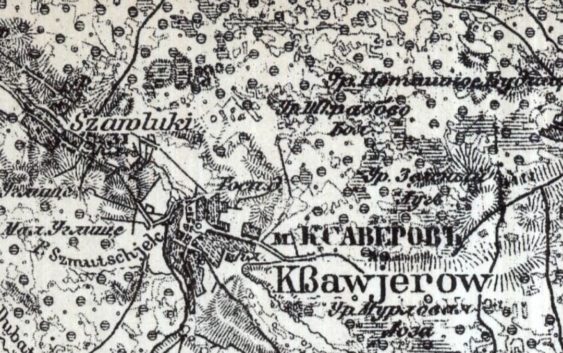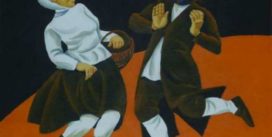The village of Ksaveriv and Its Jewish Past

The village of Ksaveriv, located in the Polissia region, has a rich history. An important aspect of its past was the Jewish community that lived here for many centuries. Memories of this community have almost vanished, remaining only in the recollections of a few long-time residents and archival documents, but researchers and local historians continue to uncover the village’s history.
Nestled among the forests of Zhytomyr Polissia, far from major roads, was the small village of Ksaveriv. Today, it is an ordinary, typical Ukrainian village with a population of no more than a few hundred inhabitants. But a few centuries ago, it was a lively town with a diverse population that included Ukrainians, Jews, Poles, and even Russian Old Believers. The regular fairs, authorized by King Władysław IV, and the granting of Magdeburg Law speak of the town’s prosperous and eventful past.
The Jewish community, which lived here for over two centuries, is also an important part of the region’s history. Unfortunately, today, the memory of the Jewish community of Ksaveriv is preserved only in the memories of a few elderly village residents and some archival documents in the Zhytomyr Oblast Archive. To address this, after a local history trip to the village, where interviews with respondents were conducted, and work in the archive’s reading rooms, this article was written.
The first written document mentioning the Jewish community is the testimony of the Kyiv city court, which states that in 1750, a gang led by Ivan Podoliak, during a Cossack uprising (Haidamaka), robbed a local Jew of seven karbovantsi.
During the time of the Polish-Lithuanian Commonwealth, regular tax revisions were carried out to improve tax collection. Thanks to these archival documents, researchers and local historians can trace the dynamics of the population changes. For instance, from these revisions, it was found that in 1765, Ksaveriv was a kahal center, meaning it had a Jewish self-government body. The town had 73 Jewish subjects, and the entire kahal consisted of 96 Jews, with 4 in Kalynivka, 7 in Obikhody, 6 in Sarnivka, and 7 in Velyka Dybrova.
However, within a decade, in 1775, there was a sharp decline in the number of kahal members, with only 37 Jews living in the town, occupying 11 houses. The kahal community paid 192 zlotys in taxes that year (including the surrounding villages, the kahal had 68 members).
Over the next three years, the Jewish diaspora continued to decrease, and by 1778, only 17 Jews remained in Ksaveriv, living in three houses.
In 1784, the archival revisions indicate a gradual increase in the Jewish community, with 22 individuals living in 5 houses. By 1791, the number of Jews in the town had grown to 39. These fluctuations in the Jewish community’s population can be explained by the events of the first partition of the Polish-Lithuanian Commonwealth in 1772 when 30% of the territory was annexed by Prussia, Austria, and Russia. As these states pursued negative policies toward non-Christians, most of the Jewish population had to move to the central regions of Poland and Lithuania, leading to increased competition in the established economic activities of these cities.
It is important to mention the role of Jews in the economy of the rural areas during that period. As the majority of the Ukrainian population was in feudal serfdom to landowners, the peasants were limited in their freedom of movement. Large feudal landlords of Catholic or Orthodox faith were interested in obtaining additional value from the sale of agricultural products. As a result, Jews, who had more freedom of movement, gradually occupied a niche in the economy as intermediaries between the town and the village, facilitating barter trade between peasants and artisans.
After the second partition of the Polish-Lithuanian Commonwealth in 1795, Ksaveriv fell under the jurisdiction of the Russian Empire and became a town in Bazar volost of Ovruch County, Volyn Governorate.
The first half of the nineteenth century was a rather traumatic period for the economy of Zhytomyr Polissia, as the border region suddenly became remote from borders and trade routes, and there were processes of land ownership redistribution and legislative changes. However, rapid scientific and technological progress in the world and the beginning of the development of capitalist relations helped to alleviate some of the region’s problems by the beginning of the twentieth century.
By 1847, the Jewish community in Ksaveriv numbered 330 individuals. The 1858 statistical data of the Ovruch County mentioned that in the town of Ksaveriv, with 17 houses, there were 83 Jewish craftsmen (40 men and 43 women) and 313 Jewish bourgeoisie (155 men and 158 women) living in 77 houses. Thus, the total number of the Jewish community amounted to 396 people.
Certainly, such a significant community should have had its synagogue, but the first reference to the Jewish prayer house in Ksaveriv is found in the statistical data of the Volyn Governorate’s Ministry of Internal Affairs in 1859.
According to the Polish encyclopedia “Geographical Dictionary of the Kingdom of Poland,” in 1870, the town of Ksaveriv consisted of 73 houses, inhabited by 401 townspeople, of whom 224 were Jews. However, the “Materials of Statistical Research of the Volyn Governorate” for 1869 indicate the total population of 470 people, with only 82 Jews. The sharp contradictions between the population figures, as well as the decrease in the Jewish community compared to the data from 1858, can be attributed to the fact that Ksaveriv was partly privately-owned and partly state-owned, making it unclear which part of the data is presented in this particular statistical document.
Text and photo – Pavlo Zeldych






